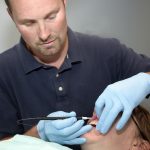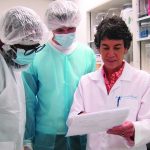
CYNTHIA GREGG, MD
FACE & BODY SPECIALISTS
For more information about the practice, contact:
CYNTHIA GREGG, MD, FACS
FACE & BODY SPECIALISTS
Cynthia Gregg, MD, FACS
Cindy Wu, MD
3550 NW Cary Parkway
Suite 100
Cary, NC 27513
Telephone: (919) 297-0097
https://cynthiagreggmd.com
A love of learning and endless curiosity led Dr. Cindy Wu to medical school, where she found—in the field of plastic surgery—her life’s passion. It blended all: her love of science and her artistic interests in photography and sculpture. “I knew that I wanted to do surgery,” says Dr. Wu, “but when I got to plastic surgery, I really fell in love with it. I was completely fascinated by the ability to take part of someone’s body and use it to completely reconstruct another part. And, in so many ways, plastic surgery allowed me to combine all the things I love: science, anatomy, art, and working with my hands.”
A decade of practice has added another dimension to Dr. Wu’s work—perhaps the most important aspect. “I still love the technical part of my work,” she says. “The operating room is my ‘happy place.’ But the work I do—one patient at a time—has led me to appreciate the human connections in what I do. First and foremost, plastic surgery is about enhancing quality of life for my patients. Ultimately, what is true for all my patients is that they all want how they look to reflect how they feel; they all just want to be more confident in their bodies. But, while the overall goal is the same, individual goals are unique—shaped by their physiology, their lives, and their needs.
“By working with patients, hearing their stories, and understanding their needs, I am able to use my technical skills to help them to achieve their individual personal goals.”
Lessons Learned
“One of the joys in this profession,” says Dr. Wu, “is that you never stop learning; every case teaches me something. That’s because every patient is different, so every surgery is a little bit different. There are guiding principles, of course, but there are subtleties to every surgery that come with individual patient anatomy as well as individual patient goals. And designing a customized, individual surgical plan is what I do for every patient.
“I’ve learned that among the most difficult challenges of this work are misconceptions and misinformation about plastic surgery,” notes Dr. Wu. “That’s because our work is visible and very personal to the patient, so our responsibilities go well beyond technical expertise. Plastic surgery is a specialty where patient and physician need to be in sync not only about what’s desirable, but about what’s possible.
“The first step in reaching that place,” she says, “is for me to try to understand each patient’s aesthetic ideal (not mine). And I would argue that one of my most important ‘surgical’ skills is the ability to listen and to clearly understand the patient’s wishes. You can’t automatically jump into someone’s head and see what they want and then deliver what they want. So that’s part of the individualized consultation process, where I hear the patient’s stories, goals, and concerns.
“And not only do I need to understand their vision; they need to understand what’s possible and appropriate surgically. I call this part ‘managing expectations.’ And an invaluable tool in this process is our 3D imaging system, which allows them to visualize possible outcomes.
“Other considerations are also important,” she adds. “You have to take into account the patient’s medical condition—and whether they’re fit for surgery. Maybe we don’t offer you a tummy tuck right now because you’re overweight, for example. Or maybe their expectations are not realistic, because the body changes they want don’t fit their anatomy. This is all part of the process of coming to a place of a shared vision and understanding. And, sometimes, when we cannot get to that place, it’s clear that the right response to a prospective patient is ‘no.’
“When we do reach that place,” says Dr. Wu, “the next step is to design and then execute a plan. That’s what I love about my job. I can geek out on the nerdy science part of it. And then there’s the artistic part of it, and just the whole process of being in the operating room molding tissue.”
Designing the Right Plan for Each Patient
“What I’ve learned to appreciate,” says Dr. Wu, “is how very personal and individual each case is. For example, two of the most common procedures I do are implant removal and what’s known as the Mommy Makeover. And although in every case the motive is the same—to improve quality of life—the specifics are extremely varied.”
Implant Removal
“Camilla, for example, wanted her 30-year-old implants removed because of a rupture. But her foremost concern was about managing pain in the process, and she was nervous about the anesthesia and about having to take opiates after surgery. These are reasonable concerns related to any major surgery,” acknowledges Dr. Wu. “And, given the complexities of the surgeries I perform, pain management is of the highest importance. My approach involves an opioid-sparing protocol, in which a combination of non-opioid medications is used in a specific timed sequence to begin managing pain before surgery begins. With this approach, my patients need fewer opioids post-operatively while still achieving appropriately controlled pain at home. This met Camilla’s needs.
“Donna was a patient who also wanted her implants removed, but her priorities were different. She was in her late 50s and didn’t have a rupture but had had her implants for 15 years and just felt she needed a change. Her kids were out of the house; she was working out more, had lost weight, and, because of the implants, her breasts were now uncomfortably heavy, and interfered with exercise and with the fit of her clothes. She wanted a smaller breast size, and breasts that sit higher on her chest wall.
“In Donna’s case,” says Dr. Wu, “implant removal was followed by a lift and a fat transfer to give back some of the volume that was lost when the implants were removed. Using Donna’s own fat offered a more subtle volume increase—rounding out the shape of the breast and making it a little bit softer.”
Mommy Makeover
The Mommy Makeover is another of the procedures Dr. Wu does frequently. “Although it’s often chosen by women who want to get their body back to where it was before they had children,” explains Dr. Wu, “the Mommy Makeover is simply a way of describing any combination of breast and body surgery. This procedure is highly individualized, and might include anything from breast reduction or augmentation to a breast lift—combined with a tummy tuck or liposuction.
“Marjorie—one recent Mommy Makeover patient—is a 55-year-old woman who wanted both a breast reduction and a tummy tuck,” says Dr. Wu. “But her body mass index (BMI) was too high for the tummy tuck—due, in part, because her overly large breasts had made exercising difficult. So, we started with a breast reduction, which would allow her to exercise more easily and get her BMI to a healthy level. And that’s what happened. After her breast reduction surgery, Marjorie was able to lose weight and became a candidate for the tummy tuck surgery. Ultimately, she was able to achieve the results she wanted—but using a safer, phased approach.”
A very different patient—Deborah—also benefited from a Mommy Makeover. “Deborah is 27 and has not had children, says Dr, Wu. “However, she had sagging, extra skin on her breasts and abdomen, not as a result of pregnancy, but from excessive weight gain and weight loss during puberty. And, although Deborah was young and tried hard to exercise, she struggled with a lot of extra skin that didn’t retract due to being stretched out from weight fluctuations. She also had a congenital condition known as a tuberous breast deformity, where the breast has a more tubular shape to it. So, her surgical plan included implants with a lift to reshape her breasts, along with a tummy tuck.”
Weight Loss Issues
For other patients, body surgery may be an important part of a comprehensive weight loss experience, explains Dr. Wu.
“Suzy is one such patient. She is 47 and had done the hard work of losing 90 pounds the healthy way—with diet, exercise, and lifestyle changes. It was an impressive accomplishment, and the results were gratifying in many ways. But one of the inevitable results of such extreme weight loss is excess skin—stretched by excess weight. Her breasts sagged and the excess skin was a burden.
“Suzy wanted her sagging breasts lifted and her abdominal skin removed. So, we worked together to design a surgical procedure that would address these issues. Her surgery included a breast lift and abdominoplasty, during which over five pounds of skin were removed. Now she is thrilled with her results; she feels lighter, her clothes fit her better; and—most importantly—she has regained her confidence!”











